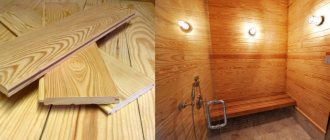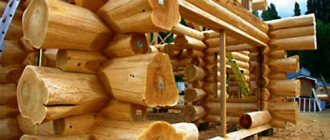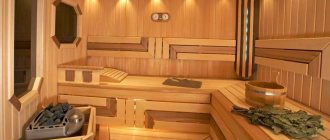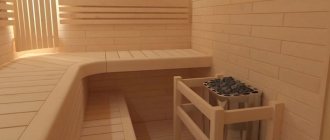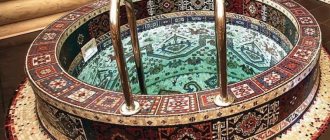We use alder in the bathhouse
Description of alder
Alder grows in ravines and along their slopes, and often settles in floodplains and meadows with excessive moisture; for this reason, it rarely ends up in cutting areas designated for felling. But even of those that end up there, the share of industrial wood among them will be very low.
Trees of this species do not often reach the age when they become thick and tall enough to go into assortment; they often die off without reaching their best qualities. In addition, as mentioned above, among them there are many trees with crooked trunks, which complicates the production of high-quality lumber.
Taking all this into account, alder is most often used as firewood, because it burns well, does not emit resins and produces a lot of heat. It is also used for making crafts or blanks for wood carving, in particular where there is little linden.
So it would have continued to remain in the shadow of its more famous deciduous relatives, if not for the increasingly popular lumber from it. After all, the unusual color of wood, pleasant aroma and good properties simply turned out to be difficult to ignore.
Properties of wood
Its structure is uniform, the core is distinguished only by a more saturated brownish tint, just like linden and aspen, the wood is soft and easy to process. It also stains and soaks well.
To use it in a bathhouse, let’s look at its other equally important properties:
Among the shortcomings we note:
- mediocre flexibility, or rather the worst in its class, - complexity of preparation and relative high cost of quality assortment, - poor resistance to rotting.
For the last point, let’s make a clarification, noting that it behaves this way only in the open air; once in the water, it acquires amazing resistance to rot. In the old days, it was for this reason that it, along with larch, was used to build various water structures.
Currently, given the growing demand for this species, alder began to be harvested purposefully, and not incidentally, as before
Where is alder used?
Alder has been used in the construction of bathhouses since ancient times; log houses, kutniks and bath utensils were made from it. Basically, it was used in areas with a lack of coniferous forests. But only recently has it gained popularity everywhere.
This is, first of all, due to development, or more precisely, to a change of views when decorating and arranging bathhouses. Many people are simply no longer satisfied with the usual finishing made of aspen, linden or pine; they want to see something more exotic, for example, alder, African abash or cedar.
Unlike other small-leaved species, a limited number of types of products are made from alder, these include, first of all, lining, shelves and small moldings (liners, plinths, casing). It is less common to find block houses and imitation timber on sale, and doors and windows are even more rare.
Alder lumber is produced in Russia from its own raw materials, and also comes to the market from Belarus and Finland
This material, in general, like other similar products, is manufactured according to European standards. Manufacturers mainly offer material with lengths from 1m to 3m in increments of 10cm, although production from 0.5m to 4m is possible.
Dimensions vary within the following limits: thickness 14-16mm, width 85-140mm. The most common is 15x90mm; there is also a narrow lining - 14/15x52mm.
Varieties: Extra, A and B.
The cost depends directly on the size of the product, but we will still give approximate prices for an estimate for 1 square meter:
— 980-1370 rub. Extra, — 850-1250 rub. A, - 700-1150 rubles. IN.
Probably only alder can replace linden as a material for a regiment. It tolerates high temperatures and humidity well, and there is no need to worry that the wood will warp or crack. And what kind of aroma will be in the steam room for a long time - wow, almost no worse than linden.
And the unique texture and color will delight any bath connoisseur. All that remains is to take care of it, protecting it from sweat and dirt.
Extra grade 27x90 - 165 rub. linear m. Grade A 27x90 - 140 rub. linear meters
Without detracting from the merits of other tree species, I would like to say that alder is one of the best of its kind for interior decoration. And considering that it grows in our country, it turns out to be a very traditional material, which perfectly corresponds and is suitable for a real Russian bathhouse.
Source
Rare breeds
When it comes to “Extra” class lining, it is expensive, because its quality is at a very high level. Compared to others, these materials look beautiful, are durable and have superior technical characteristics.
In terms of sophistication, oak is the best. Panels made from this type of wood are heavy and have an incredibly beautiful texture. In addition, oak structures have always been famous for their durability.
Abash (African wood) is also often used to decorate baths. It will not heat up, even in very high temperatures. And this is its unique property. Therefore, this breed is very often used to make shelves for the steam compartment. They also line the ceiling and walls.
Alder lining for finishing a bath
Alder lining is one of the elite building materials. Many experts claim that alder is the best board for interior decoration of a bathhouse or sauna. A log bathhouse made of alder is a centuries-tested material. True connoisseurs of saunas and baths unanimously claim that the finishing of bath rooms should be made only from alder. Why is there such an opinion? The thing is that alder is characterized by low thermal conductivity: no overheating and no thermal burn for you. Wood contains aromatic compounds (essential oils) and tannins, which have a beneficial effect on our health. Alder lining for steam room decoration is very popular. Alder lining boards lend themselves well to processing, they are easy to cut, do not chip, crack or break during the drying process.
cold cucumbers for storage in the apartment
Properties of wood
Natural alder lining has unique properties that allow this product to occupy a special place among all other types of lumber: • a beautiful chocolate color with a red tint and a unique texture give alder lining the highest aesthetic characteristics; • the water-repellent effect of this wood is one of the main criteria for its use in hydraulic engineering construction, as well as in the finishing of saunas, baths and wells; • the complete absence of resin secretions allows the use of alder as firewood in smokehouses; • calm alder lining has special healing properties: bactericidal, anti-inflammatory, tanning, and carries with it positive energy and a huge charge of vivacity; • wood is very easy to process, which is highly valued among manufacturers; • the durability of alder wood is due to its minimal ability to dry out; • alder lining, which can be purchased in many specialized stores, also has the best combination of affordability and quality of lumber.
Types and sizes of lining
The production of lining is regulated by the following standards: GOST 8242-88, DIN 68-126/86, TU. It is worth noting that the German DIN standard is more demanding in terms of quality than the Russian GOST.
Before the lining goes on sale, its grade is determined. The fewer defects, knots and roughness, the higher the class of the lining. Domestic grades 1, 2 and 3 correspond to European ones - Class “A”, “B”, “C” . In addition, European and then Russian manufacturers began to offer “elite” or “extra” class .
Alder lining “Extra” (highest grade)
Alder lining class “A”
Alder lining class “B”
Let’s immediately make a reservation that the dimensions of the lining will be different for regular and eurolining. Dimensions of regular lining , i.e. its length, width and thickness are determined directly by the manufacturer. But the most popular are the standard parameters.
Dimensions of eurolining: (more precise parameters are typical) • thickness: 13, 16, 19; • width: 80, 100, 110, 120 mm; • length: 0.5 m – 6,000 mm; • spike size: 8-9 mm.
Advantages of alder lining when finishing a bathhouse
Due to its unique performance characteristics, alder lining is used primarily for finishing baths and saunas. Wood has a low coefficient of thermal conductivity, as a result of which the board retains heat well, does not crack or warp at high humidity and temperature, does not emit resin, and due to its low hygroscopicity, practically does not absorb water.
When arranging walls and ceilings in saunas and baths, it is recommended to buy alder lining, which has a beneficial effect on human health. Alder wood, one of the few species, contains a large amount of tannins. Finnish lining made of black alder is also very popular. At high temperatures, medicinal vapors are released from the covering of the boards, which help strengthen the immune system, normalize blood composition, and also have a beneficial effect on the nervous and cardiovascular system of lovers of water treatments. It is also recommended to purchase doors made of solid alder for saunas and baths, which will add even more color to your building.
Features of finishing with alder lining
When cladding walls in a bathhouse, consider the following features: • Before installation, the lining must be stored for some time in the room where it is planned to be installed. This procedure is considered mandatory, as it protects your finished walls from deformation due to changes in temperature and humidity in the room. • You cannot use any coating for shalevka, especially drying oil, because the material will heat up and release harmful compounds from the high temperature. • If your bathhouse is made in the form of a wooden frame, then you will upholster the lining directly on the walls of the building, because the walls in such a room will be smooth. If your capabilities, time, and experience allow you to install the cladding correctly, then make a sheathing - a frame for a shalevka made of alder. For the sheathing, take slats, which you install at a distance of about 50 cm with nails or screws in relation to the boards, as always, perpendicularly. The frame provides additional air circulation and prevents moisture accumulation. • Before construction work, it is important to decide in which direction you will upholster the lining. Theoretically, horizontal and vertical installation is allowed. But judging by reviews from the Internet, a horizontal arrangement of the shalevka is ideal for a bathhouse. In the bathhouse, the highest temperature is always located at the very top of the room, fresh air is redirected by ventilation from below. Humidity is distributed in the opposite direction: higher – less humidity, lower – more. • It turns out that the most unfavorable conditions for wood shavings are created at the bottom of the wall covering. All this is reflected in the service life of the material. • The vertical position contributes to uneven heating of the shalevka. Imagine how many times the lower part of this wooden material will be subject to temperature changes. The finishing will bend along the plane, warp, its original shape will change, and then it will not be far from rotting from the influence of humidity changes and the final result: forced repair of the finishing fabric. • When installed horizontally, each finishing panel is at a certain level and, accordingly, the entire panel will be subject to a certain effect: the entire panel will heat up equally and will also be exposed to moisture. Deformation of the entire wall will not occur, since the conditions will be normal and will not affect the general condition of the wall. Only one bottom row, which is closer to the floor, will be most susceptible to rotting and mold.
box for the air conditioner unit on the balcony
Experts say that the best way to decorate the walls in a steam room is horizontal, in which you will not need to change the entire cladding, just remove a few panels. In the process of finishing the steam room, you also need to focus on the most ideal location of the facing sheet; you need to start laying the finish from the top of the wall, placing the lining with the groove down, and the next element should be inserted into the groove of the shalevka already attached to the wall. When cladding the steam room, choose only wood lining that will not release resin when heated, so alder lining is ideal. There is no need to completely abandon the vertical direction. In the photo on the Internet, the finishing of a bathhouse with different directions looks beautiful; you can, for example, join a small lining using a special fabric. Do not forget to mount the first and finishing boards with nails, cutting off the heads on them, because touching them can cause burns. To prevent rusty stains from appearing on the lining when exposed to moisture, use only fasteners with galvanized coating.
Source
Classes
According to quality, the lining is divided into the following classes:
The highest is the Extra class . The panels have no defects. Typically used for cladding luxury private houses. The price is affordable for wealthy people.
Category A is slightly behind in terms of characteristics. It allows a small number of shallow cracks up to 9.5 cm in length, light-colored captive knots no larger than 1.5 cm in size and a maximum diameter of 0.5 cm.
Class B may include any defects, chips no longer than 5 cm per linear meter of material. The presence of blue up to 10% of the area, knots, resins, cores is allowed. Rotten and falling out branches are unacceptable. Any existing damage should not interfere with installation; it can be hidden under dark paint. The most common option.
Category C is mainly used for rough finishing. Requires adjustment and additional painting before finishing. On most of the coating there are falling knots, through cracks, cores, bark remains, and chips.
Currently, craftsmen value a new modern type of finishing board - eurolining. The material is considered high quality, is distinguished by deep connecting grooves, has ventilation channels, and is also larger in width and height compared to standard lining.
Main characteristics of alder. Features of appearance and production
Alder is a common type of wood in northern latitudes, ranging in color from reddish-white to deep brown. After cutting, the wood becomes bright red due to oxidation. The final tone of the material appears after technological drying.
The structure of alder is inelastic and soft, requiring careful processing when using the material for finishing external structures. When drying, the wood dries quickly without losing its parameters and quality characteristics, without cracking or warping. Manufacturers value alder for its flexibility in processing. It is perfectly planed and sawed, glued and polished. Finishing of alder in the form of staining and final varnishing also occurs without problems or flaws.
Advantages
Aspen wood has low thermal conductivity and almost does not crack; it lends itself well to various processing techniques, even bending. It can be easily polished and painted. The material is relatively light, attractive white, with fine fibers. Ease of processing is also associated with a minimal number of knots. If processed correctly, objects become strong and resist rotting very well.
The condition of patients with rheumatism, bronchial and pulmonary inflammation, even dysentery improves
It is important to remember that this cannot in any case replace full-fledged treatment, and any measures of this kind must be agreed with doctors
Scope of use of alder
Alder wood is used to produce high-quality veneer, chipboard and plywood. Material shavings as an antiseptic binder are included in certified boards made from beech and pine. Preparations of this type of wood are in wide demand for the production of environmentally friendly and safe toys for children, furniture and various decorative elements. However, alder lining is most in demand for finishing baths and saunas, due to the unique aesthetic and performance characteristics of the material.
Useful tips
If the owner of a bathhouse decides to independently finish the alder paneling without the help of specialists, it is worth listening to the following installation tips:
- It is better to place the panels vertically or diagonally, this method will prevent splashes from getting into the grooves between the boards;
- the lathing for alder lining is made only from wooden beams;
- iron products quickly rust, so you need to choose galvanized materials as fasteners;
- if you slightly sharpen the fastening corners and strips, then the falling drops will flow down faster;
This tree also has disadvantages:
Unlike cedar and linden, alder, unfortunately, lasts much less. Despite this, many people buy it because of its beautiful texture.
The panels have beautiful shades from golden to bright red. With their help, you can decorate a room not only practically, but also tastefully. Alder exudes a subtle scent that cannot be confused with any other scent. A steam room with such a finish will look impressive, exclusive and rich.
Alder lining, the price of the material is quite affordable in a budget option and for a wide range of buyers! Before installing the board, you need to lay it out for some time in the room where it will be installed so that it “adapts”, gains the necessary humidity or, conversely, dries out. This procedure is carried out without fail, protecting your walls from deformation due to temperature changes in the room.
Medicinal qualities
Alder contains tannins that prevent the proliferation of microorganisms. When heated, the material releases elements that provide hemostatic and anti-inflammatory effects due to its disinfectant and astringent properties. Thus, visiting a bathhouse decorated with alder paneling has a beneficial effect on various ailments: rheumatism, colds, gout.
Therefore, the use of boards from this type of wood is recommended for the construction of steam rooms, saunas with infrared radiation, and for interior decoration.
Despite the widespread use of alder lining, this raw material also has some disadvantages:
- due to heating, the alder may turn red, later it will take on a completely dark shade, and then there will be a need to improve the lighting in the room decorated with alder lining;
- the presented type of wood has a specific aroma, some call it cognac, although after some time it almost completely disappears;
- alder is beautiful in its external characteristics, but is still inferior to some other deciduous species;
- the trunk may have dark spots and rot; this does not affect the strength of the lining and its aesthetics, but it does affect the price; more precisely, this tree has a small percentage of board yield that can be allowed for the production of lining.
Aspen bathhouse: pros and cons
If larch is used both as the main material and as a finishing material for the steam room, then with aspen the situation is different. This tree is very specific and not cheap. Moreover, the cost is determined not by high qualities, but by the features of the workpiece.
Aspen grows in wetlands, which causes the inside of the trunk to rot. You can only harvest aspen tops up to 4–5 m in length. The rest of the tree is unusable and is simply thrown away. In addition, aspen harvesting is only possible from March to May, while aspen is relatively easy to process. This “seasonality” makes the collection and supply of material a very expensive endeavor.
And yet, this is the material that people often prefer to linden and alder. In fact, the disadvantages of aspen turn into advantages when it comes to the steam room:
An aspen bathhouse lasts for decades, and over time it only becomes stronger.
Important! Aspen wood is very wet and shrinks greatly when dried. However, once it dries, it becomes rock hard.
How to compare materials correctly
Of course, there are financial resources and time, quite realistically, and universal solutions.
For example, build a log bathhouse from cedar, preferably Canadian, and use African oak to decorate the steam room. Even with a successful design, steaming in such a bathhouse is not much better or more comfortable than in a regular one, but it will last ten times longer than a log house made of aspen or even larch. Wood used in bath construction is divided into three categories:
- Finishing material for steam room walls, shelves, bath accessories;
- Material for arranging the wettest parts of the bathhouse;
- Wall block or timber.
This division did not arise by chance; as a rule, a certain type of wood performs best under certain conditions. For example, oak or larch are better suited than pine or alder for a bathhouse when it comes to constructing a log house or building frame. At the same time, heavy oak, acacia or birch are never used for wall decoration of the steam room. The denser the wood, the more it burns the skin, and birch board also produces bitterness.
Linden or aspen for a bath: which is better?
It's really difficult to choose between these two materials. Linden is traditionally considered the best tree for a bathhouse and deservedly so. However, aspen, despite its external ugliness, poses serious competition to it.
Linden wood is soft, it is easy to process, and accordingly, the construction of a bathhouse requires less cost. If dried logs were used, the building does not shrink and can be used immediately after completion of construction.
Aspen, on the contrary, is processed with great difficulty. Since a bathhouse requires well-dried material, this makes construction an expensive and time-consuming task.
loan to buy out a share in an apartment
The softness of linden is also its disadvantage - the tree is short-lived, but dry aspen acquires the hardness of stone and lasts an exceptionally long time. Linden does not need to be processed for aesthetic purposes; even an unsanded log looks great, not like lining. To give aspen an aesthetic appearance, you should trim the bark from the log, sand it and plan it. In addition, repeated grinding will be required - the latter is performed 3 years from the date of laying. Otherwise, instead of a silver-white bath, you get a gray, unsightly one with dark spots.
Linden is not resistant to rotting and fungal attack. The bathhouse requires periodic treatment with special preparations. Aspen is not susceptible to rot or fungi. The only treatment that may be needed is for wasps. For some reason, the latter really love this tree.
The cost of linden is higher than that of aspen, so it is really difficult to choose.
Important! A log house for a bathhouse made of aspen and linden, as confirmed by reviews from builders, does not require additional finishing of the steam room. Both breeds are certainly suitable for sauna lining.
How to distinguish linden from aspen
Lining made from linden and aspen is very easy to confuse. It is not so easy to distinguish wood.
First of all, pay attention to the color. The wood of linden lining is very light, but still has a coffee tint. Against its background, the aspen is almost snowy white.
Linden boards have a characteristic sweet aroma. The smell of aspen is bitter, more reminiscent of birch sap. Aspen lining is rarely truly smooth, since this wood is difficult to process, but linden is smooth and silky;
To distinguish linden boards from aspen boards, you need to not only inspect them, but also try them by touch.
What is better in a steam room: aspen or linden
The choice between linden and aspen lining is even more difficult. The materials have a number of common properties that are very useful for saunas and steam rooms:
There are also differences between linden and aspen:
For a steam room, linden or aspen linings are equally good. The choice determines the taste of the owner.
Reviews
Larch bathhouse
Boris Nevelov, 42 years old, Novosibirsk
I hesitated for a long time between linden and aspen, but in the end I made the traditional choice: linden. It costs more, but for a steam room, I think, you won’t find a better one. The wood is warm, silky, and does not heat up. And the smell in the steam room will make you pumped.
Nikolay Morozov, 35 years old, Omsk
There used to be a bathhouse on the site - made of pine. The inside of the steam room was lined with linden. But something went wrong: it began to rot. And in the bathhouse there was always mold or something else. They dismantled and built a new one - from aspen. It has been standing for more than 6 years, nothing rots, there is no trace of fungus. But, of course, it took me a long time to choose a tree. I went to the base three times to take away the barrels.
Alexander Fedorov, 52 years old, Ufa
A bathhouse was started on the site as soon as the house began to be built. I chose aspen: the price is lower than cedar, and it is not afraid of water, if it is good. Banya is already 15 years old. The color, of course, is not the same, it has become gray, but the tree is like stone. During all this time there was never mold in either the steam room or the dressing room.
Tags: bathhouse, linden, alder, good
« Previous entry
Cedar for a bath
Noble cedar wood belongs to the elite category. The material has exceptional qualities, not only functional, but also medicinal.
Cedar wood is impregnated with unusual resinous substances. They call it gum, emphasizing its special qualities. It has an antibacterial effect not only on the wood itself, but also on the environment. When heated, the substances begin to evaporate, disinfecting the room and relieving a person of a wide variety of diseases, so cedar is ideal for a steam room.
Important! In Siberia, a bathhouse decorated with cedar clapboard is recommended for those suffering from diseases of the respiratory system. The tree can even cure bronchial asthma.
Log bathhouse made of cedar
Cedar is the best option for a bath. The qualities of wood provide the log house with durability, beauty, and convenience:
There is only one drawback to cedar wood or lining - high cost.
Cedar lining for a bathhouse
Cedar lining for a bathhouse has all the advantages of a log. This material is ideal for a steam room, although it is not as effective as aspen:
Important! Over time, cedar lining darkens, or rather, acquires a brownish tint.
Cedar bath: photo
Cedar is an excellent building material and allows you to implement any project - from a traditional Russian bathhouse to a complex hotel complex.
Finishing with paired cedar lining is no less impressive and beautiful and is suitable for any style.
Healing power
Alder is also widely used in medicine. The bark and leaves are used as a remedy for inflammation and wound healing in the form of tinctures and decoctions. Wood has the same properties. Therefore, alder lining in bathhouses improves health. Products made from such wood do not emit resins at any temperature.
Alder is used not only for finishing baths and other premises; it is also used in furniture making because of its decorative and attractive properties. This material has a wide range of applications and mostly positive reviews.
The wood has an attractive yellow-red color. When cut, the tree has a delicate small pattern. In addition, soft fibers make it possible to make thin elements from alder without losing their qualities. Including strength.
Alder is also used for the construction of hydraulic structures. It is almost unaffected by surrounding atmospheric influences.
Alder has long been popular for its healing properties. It is widely used in the arrangement of steam rooms, saunas, and interior decoration.
The justification for its medicinal qualities is simple: the wood contains tannins. Why does it have such magical healing powers? When exposed to high temperatures, wood releases substances that have disinfectant and astringent qualities, which help stop bleeding and prevent inflammation of wounds and burns.
For rheumatism of the joints, diseases of the joints due to metabolism, various colds, and problems with the respiratory and nervous systems, procedures in the steam room using alder are recommended.
According to the convictions of true connoisseurs of the bathhouse, the steam room compartment must be lined with alder paneling.
If, when finishing work indoors, the choice was made on lining, then the best option would be wood products. Natural material is always environmentally friendly; it also evokes a large number of positive emotions. Helps get rid of illness, improves mood and energizes. By carrying out finishing work on residential premises and recreational areas from natural materials, at the same time, we show concern for the health of ourselves and our loved ones.
Varieties
Initially, the external appearance of the lining was only flat, but recently other forms of cladding have begun to appear. From the old version, only the method of joining the panels has been preserved, similar to the principle of joining a floorboard. Now this design is also used in the manufacture of plastic panels. The most common lining options have characteristic names.
- Block house. The panels have a profile that visually creates an imitation of a wall made of logs. All other characteristics remained the same as those of conventional lining.
- Panel. The principle is the same as that of a block house, but the imitation is created not of a log, but of construction timber.
- American. The lining of this lining is wedge-shaped, giving the impression that the panels are overlapped. In this case, docking is carried out in the usual way.
- Calm. This variety looks like a simple processed board. It looks like a continuous homogeneous surface without joints. Although they are present.
Bottom line
Based on all of the above, we can conclude that alder is perfect for interior decoration of a bathhouse . But it is not recommended to make the log house itself from it. This is not only unprofitable, but also not advisable. Also, do not save money by choosing a low grade of wood. After all, a bathhouse is not built for one year, and poor quality can soon have a negative impact on operation.
1Drevo.ru «Wood species1 June131798
The Russian bathhouse made of alder receives mixed reviews. Some people like the absence of resin, others are dissatisfied with the color of the wood after a few years. What this material actually is is worth examining in more detail. Because construction from natural raw materials is not cheap and the consumer should take into account all possible risks.

